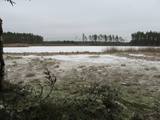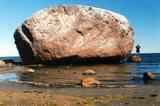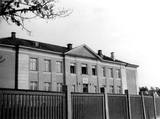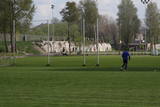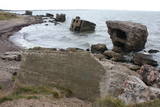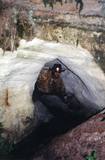| Nr | Name | Beschreibung |
|---|---|---|
|
Das ist eine der eindrucksvollsten und großflächigsten natürlichen Strukturen seiner Art in Lettland hinsichtlich Erscheinung und Landschaft. Die Eiszeit hinterließ dieses mauerartige Terrain, das bis zu 27 m hoch ist. Oben drauf wurde die Straße Rīga-Ērgļi gebaut. Die Großen Kangari – Berge bieten eine Aussicht auf den Großen Kangari – See und die Großen Kangari – Sümpfe und – Teiche. Der Ķoderi – Burgberg, auch als das “Bett des großen Mannes” bekannt, befindet sich auch hier. Das Schutzgebiet wurde errichtet, um die Struktur und seine zugehörigen Biotope und Pflanzen zu schützen.
|
||
|
Beim Besuch der Bierbrauerei kann man den Prozess der Bierherstellung kennenlernen. Verkostung der Biersorten und Malzgetränke, die in der Bierbrauerei hergestellt werden. |
||
|
Taka iesākumā ved pa mežu ieskautu bijušo šaursliežu dzelzceļa līniju, pa kuru pagājušā gadsimta vidū izveda kokmateriālus. Tās tālākā daļa izmet nelielu loku pa Suistna purvu (Suistna raba), kur uzcelts skatu tornis ar izcilu sūnu purva ainavu ar nelieliem ezeriņiem. Takas garums vienā virzienā ir 4,5 km. |
||
|
Der älteste und größte Getränkehersteller Estlands, die Brauerei A. Le Coq, lädt die Museumsbesucher, die Geschichte der Bierbereitung und Bierkultur, moderne Bierherstellung kennen zu lernen sowie das Bier zu probieren. Die Besucher können mehr als 2000 Ausstellungsgegenstände besichtigen und in der Museumskneipe sowohl Bier als auch andere gute Sachen probieren. Bier und dazugehörige Snacks sowie Souvenirs kann man im kleinen Museumsladen kaufen. |
||
|
This is the largest rock in the Baltic States and, according to some sources, in all of the segment of Northern Europe which was affected by the last Ice Age. Its size is 930 m3! The rock is 7.5 m high, 16.5 m long and 14 m high, with a circumference of 48.5 m. The rock resembles a huge pebble from a distance, and it is on the sandy and rocky beach. Depending on the season, it can be out in the water. The Ice Age carried the rock to its current location from the southern shore of Finland. It is made of pegmatite.
|
||
|
Aptuveni 0,5 km dienvidos no Mežotnes pilskalna atrodas Vīna kalns, kas līdzīgi kā Mežotnes pilskalns, ir veidots, izmantojot Lielupes ielejas stāvās krastu nogāzes, tās pārveidojot. Vietvārds ir it kā radies no stāsta, ka šeit parādījies dievgalds ar maizi un vīnu. Vīna kalnu ar Mežotnes pilskalnu savieno jauka koka laipa, kas ved pa Lielupes ielejas pamatkrasta lejas daļu. |
||
|
The roots of Saulkrasti Secondary School reach back to Pabaži, to 1912, when a young teacher – Olga Veicmane (after marriage: Cīrule) arrived from Riga to teach the sea captain Reisons’ daughter. Soon many other tutor-seekers joined her and in autumn of 1912 a school was established in Pabaži. The school had a good reputation, and pupils came from the entire surrounding area. In January of 1913, the school was moved to more spacious premises at 20 Rīgas Street. |
||
|
A farm engaged in the cultivation and processing of large cranberries. Offers berries, cranberry juice, syrup. On Fridays at Dundaga market from From 7:00 to 11:00 it is also possible to buy products. |
||
|
Madonas centrālais laukums, kas vēl 20. gs. sākumā bija tirgus laukums. Pēc apjomīgās restaurācijas tas ir kļuvis par ievērības cienīgu pilsētvides objektu. Laukuma ziemeļu pusē atrodas pilsētas un novada pašvaldība un Madonas novada TIC. |
||
|
Diese dreitägige Tour beinhaltet eine Vielzahl von kulinarischen Höhepunkten. Die Busfahrt wird mit Radtouren auf der Insel Kihnu kombiniert. Auf der Reise werden Bauernhöfe und Erzeuger besucht, die Lebensmittel aus regionalen Zutaten herstellen. Dabei werden Apfelwein, Fisch, Kräutertees, Bier, Milchprodukte und Gebäck verkostet. Die Besucher lernen traditionelle estnische und russische Haushalte kennen und genießen dort echte Hausmannskost und erleben reiche Traditionen. |
||
|
Leuchtturm von Tahkuna befindet sich an der Nordspitze von Hiiumaa. Der eiserne Turm wurde aus Frankreich gekauft und im Jahr 1875 in Tahkuna errichtet. Es ist der höchste Leuchtturm an der Küste von Estland – 42,7 m über Meeresspiegel. |
||
|
This is one of the most beautiful gardens in Latvia, and the owners of the garden will offer you a tour, along with valuable advice. Visitors can purchase trees, bushes, winter plants, perennials, medicinal plants, as well as edible flowers. Florist services are also available. |
||
|
Near Mākoņkalns hill there is a trail that is mowed in the summer and leads to several historical rocks – Plakanais (Flat) rock, Āža muguras (Ram's Back) rock (on which you can clamber), and the Jaunstašuļi Velna pēdas (Devil's Footprint) rock, on the surface of which is a shape similar to a human footprint. There are signs along the side of the road leading to the trail. |
||
|
Ein kleiner Teil von dem beeindruckenden Fortifikationssystem von Liepāja, das die Stadt die Küste der Stadt umgibt. Er befindet sich am Stadion „Olimpija”. Siehe auch die Objekte Nr. 30077, 30078, 30079, 30080, 30098.
|
||
|
This 1995 sculpture by Oļegs Skarainis is at the corner of Dinsberģa and Talsu streets in Dundaga, near the local dairy. It is dedicated to the strong men of the town, including former Dundaga resident Arvīds Blūmentāls (1925-2006), who lived in Australia, was a great crocodile hunter (some 10,000 in all), and served as a prototype for Paul Hogan in the famous movie “Crocodile Dundee.” |
||
|
Ilmārs Vecelis takes part in the “Potter School” of the Latvian Cultural Fund and, therefore, uses ancient pottery methods that have been tested over the course of many centuries in Latgale. You can tour his workshop, attend the opening of the kiln, try your own hand at the craft, and commission and purchase finished ceramics products. |
||
|
The farmstead grows apples, strawberries, black currants, red currants, etc., berries and fruits; there is a big selection of processed goods: natural juices, nectars and syrups. There are offered apple, strawberry, red currant, gooseberry, sea-buckthorn and chokeberry saplings; consultations are given for making out a commercial garden and taking care of it. Excursions around the commercially grown plants. |
||
|
Eine von der visuell ausgeprägtesten Batterien der Küstenwache. Warum? Die Positionen der Batterie und die einzelnen Elemente sind ganz oder teilweise im Meer eingespült worden und dabei entsteht eine nicht für Meeresküste Lettlands charakteristische Ansicht. Sie sind besonders beeindrucksvoll in der Zeit der Stürme. Leider ist dieses historisches Denkmal den mächtigen Vorgängen der Naturkräfte ausgesetzt. Die Batterie kann man auch von der nördischen Mole von Liepāja sehen. Es lohnt sich die 4 km lange Strecke entlang der Meeresküste bis zu den nördischen Befestigungswerke zu Fuß zu gehen. Bei der Gelegenheit kann man auch die Positionen der Küstenschützbatterie 23 besichtigen.
|
||
|
Madonas ainavai zināmu šarmu piešķir Leivērītes un Madonas upītes gravas, kuru atsevišķiem posmiem doti dažādi nosaukumi. Mīlestības gravas krasti ir iecienīta pilsētnieku pastaigu un atpūtas vieta. Gravas nogāzē aiz 2. vidusskolas ieslēpusies "Lazdu laipa", kas pazīstama no rakstnieces (šejienes novadniece) Ilzes Indrānes romāniem. Parka dīķī esošo strūklaku uzskata par Latvijā augstāko. Mīlestības gravas turpinājums ir Laulības un Šķiršanās grava. |
||
|
Vairāki dažus metrus augsti smilšakmens atsegumi, kas izveidojušies Stiglavas (Stiglovas) strauta gravas nogāzēs. Kaut arī teritorija tiek popularizēta kā tūrisma objekts, tajā nav īpašu šim nolūkam paredzētu labiekārtojumu. Teritorijas apmeklētāji bojā smilšakmens atsegumus, kas ir aizsargājami biotopi!
|
||
